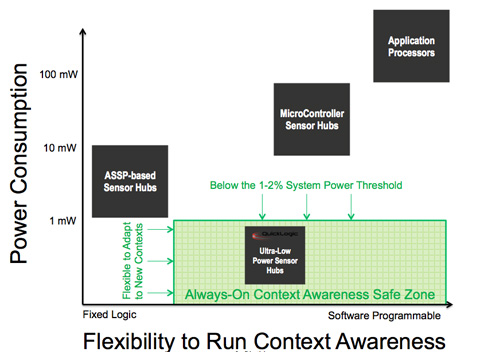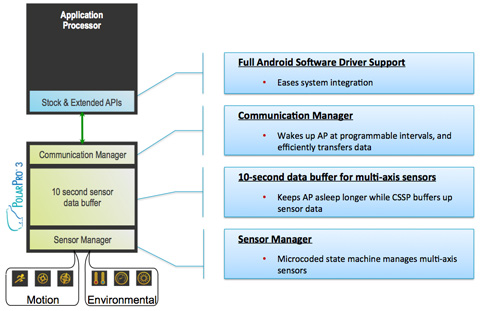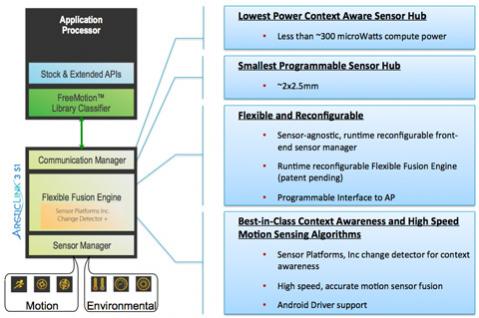 Smartphones are smart but they are about to get smarter. The next big thing in mobile phones is to have a rich sensor environment: proximity, temperature and humidity, atmospheric pressure, light color, cover, gyroscope, magnetometer, accelerometer, ambient light, gesture and more. Some of these are already here, of course, and some don’t require much in the way of processing. But the big promise is to have always-on (so powered up even when the application processor is in standby mode) and context aware (pedestrian dead reckoning like Fitbit and Nike FuelBand but aware of whether you are running, walking, biking, on an escalator and so on). These will allow all sorts of new applications to be part of your smartphone, which since it is always with you means it can pull together data from lots of sensors to be even smarter: it knows when you are sleeping, it knows when you’re awake, it knows if you’ve been bad or good…well, maybe that’s a bit too far.
Smartphones are smart but they are about to get smarter. The next big thing in mobile phones is to have a rich sensor environment: proximity, temperature and humidity, atmospheric pressure, light color, cover, gyroscope, magnetometer, accelerometer, ambient light, gesture and more. Some of these are already here, of course, and some don’t require much in the way of processing. But the big promise is to have always-on (so powered up even when the application processor is in standby mode) and context aware (pedestrian dead reckoning like Fitbit and Nike FuelBand but aware of whether you are running, walking, biking, on an escalator and so on). These will allow all sorts of new applications to be part of your smartphone, which since it is always with you means it can pull together data from lots of sensors to be even smarter: it knows when you are sleeping, it knows when you’re awake, it knows if you’ve been bad or good…well, maybe that’s a bit too far.
The challenge to make this a reality is that the power sensor algorithm computation has to be really low power, just 1-2% of battery life. So for a typical smartphone battery with 8K mWh capacity that is around 5-10mW.

A couple of years ago, Quicklogic decided to go after this market once they decided that they could make the power requirements. You can’t use the application processor’s main processor (typically a high-end ARM these days) since it is too high power and to optimize the system design it cannot always be on. But on the other hand, the sensor algorithms are in a state of flux and even new capabilities using existing sensors may be required as an upgrade during the life of the phone (for new apps), so programmability is a must.
Quicklogic have been in the anti-fuse based programmable area for 25 years and have had a lot of success. But anti-fuse is one-time programmable and although it has lots of advantages for some systems, for sensors in smartphones “once is not enough”. Traditional programmable logic is designed for high performance and is not suitable for mobile where power is king. So they designed their own 65nm SRAM-based reconfigurable substrate and then used it to build two products for the mobile sensor market that come in under the 2% battery limit that nobody else can reach.

The first product in the PolarPro 3 family, is a 10 second sensor data buffer. This offloads the application processor so that it can basically sleep for 10 seconds, wake up, do the calculation and then sleep again, analogous to audio processors for playing mp3 although the data is going in the other direction.

The more interesting product is ArcticLink 3 S1 contains a custom compute engine which they worked with Sensor Platforms Inc to use their change detectors and algorithms. This offloads most of the sensor processing from the application processor. It can sense device motion (shake, rotate, translate), where carrying (not on person, in hand front, in hand side, in container), posture (sitting, standing, walking, running) and (soon) what sort of transport you are using (in car, on train, in elevator, going up stairs). It also handles environmental sensors such as temperature and pressure.
 This technology enables a step-function increase in the capabilities that a smartphone and its associated apps have, especially in the health and fitness area. I can’t wait to have one in my next phone. My Fitbit is good but it gets confused on a bike ride or an escalator.
This technology enables a step-function increase in the capabilities that a smartphone and its associated apps have, especially in the health and fitness area. I can’t wait to have one in my next phone. My Fitbit is good but it gets confused on a bike ride or an escalator.
More details on the QuickLogic website here.
Share this post via:








Quantum Computing Technologies and Challenges